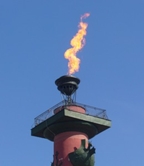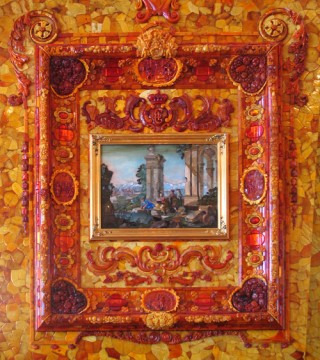 Tsarskoe Selo. The Amber roomTsarskoe Selo, a gem of Russian national culture, is a complex of unique palaces and parks built by great 18th and 19th-century Russian and West European architects. In 1937 it was renamed in honour of Alexander Push kin (1799 - 1837), the Great Russian poet. Here everything - the building of the Lyceum at which he studied for six years, the shadowy walks of the Catherine Park - reminds you ofPushkin's poetry. It was here that his gift for poetry shaped up and it was here that Pushkin created his first poetic works.
The town of Pushkin (Tsarskoe Selo) is situated 24 kilometres to the south of Saint-Petersburg. Its history, just as the history of Peterhof, goes back to the old days when the lands on which the town lies belonged to the Novgorodian boyar republic and subsequently to the centralized Russian state and which were seized by Sweden in 1617. During the Northern War, after the troops led by Peter the Great won back the lands lying between the Neva and the Southern shores of the Gulf of Finland, the territory on which the town of Pushkin now stands was also liberated from Swedish rule.
In 1710 Peter the Great gave the Saari grange (is was the name of place where Tsarskoe Selo was founded) to his wife, the future Empress Catherine I, after whom the palace which began to be here at the time was named. Between 1718 and 1724 the architect Johann Friederich Braunstein built a two-storied stone palace with service wings on the site of the grange. After the gloomy period of Bironovshchina, the domination at Empress Anne Ioannovna's court of her favourite, Biron, and of other German dignitaries had passed, Elizabeth Petrovna, the daughter of Peter the Great, encouraged the development of Russian national culture at her court.
During the reign of Empress Elizabeth I (1741 - 1761) the palace was rebuilt more than once by prominent Russian architects, including Alexei Kvasosv and Savva Chevakinsky. In 1752 Francesco Bartholomew Rastrelli (1700 - 1771), one of the greatest 18th-century architects, an outstanding master of the baroque style in architecture, was commissioned to rebuild the Catherine Palace.
Having acquainted himself with what had been done at Tsarskoe Selo by his predecessors, Rastrelli decided to make an organic link between the separate parts of the building. The new palace was much taller and its azure main facades, ornamented with a great number of columns, statues and mouldings, now stretched for more than 300 metres. One of the finest interiors in the palace was that of the Amber Room. Its amber decor which was the work of Andreas Schluter (1709) originally belonged to Friedrich Wilhelm I of Prussia The Russian Emperor was received there with great honour and this room was presented to him by Fredrich William as a diplomatic gift. In return of the Amber Room Peter presented Fridrich 55 guardsmen. During the II World War the Amber Room was taken away by the Nazi; after the war our restorers began making a new one. Eight tones of amber were used to make a new Amber Room.
Great care and protection was given to transporting the panels to Saint-Petersburg from where on the orders of Empress Elizabeth Petrovna soldiers carried the priceless cargo to Tsarskoe Selo in their arms. In 1755 Rastrelli installed the panels in the Amber Room. Since there were not enough amber panels to cover the whole room he inserted a number of mirrors on the lower part of the wall and used excellent imitation amber for the upper part. These priceless amber panels were plundered by the Nazis and have not been found to this day. During the reign of Catherine the Great (1762 - 1796) substantial alterations v.'ere carried out on the place. The gold on the ornaments and sculptures (which at the time were wooden) had not lasted long. The empress ordered them to stop any further gilding, take down the wooden statues that were peeling, and painted the moulded ornamentation. An extra storey was built on the side wings the entrance added, and the palace was given the appearance it has largely retained to this day.
To the northwest of the Great Palace the New Garden (the present Alexander Park) was laid and adjoining the garden façade of the Palace on its southeastern side was the Old Garden, known today as the Catherine Park. The second half of the 18th century is marked by the establishment of neoc1assicisn in Russian art and architecture. And it was in this style that between 1760 and 1790 a whole constellation of talented architects such as Charles Cameron, Giacomo Quarenghi, Vassili and Ilya Neyelov, Yuri Velten and Antonio Rinaldi worked at Tsarskoe Selo. It was during this period that some of the finest buildings were put up here, including the Alexander Palace, the Cameron Gallery, the Concert Hall, the Upper and Lower Baths, and also the building which housed the Lyceum and a number of other structures.
In the years of the Great Patriotic War the town of Pushkin suffered great damaged. Many priceless treasures perished in the fires and many works of art were brutally destroyed or plundered. Centuries-old trees were chopped down in the old parks, unique pavilions and beautiful statues were demolished by bomb and shell bursts. After the town was liberated on January 24, 1944, scholars, historians and restorers began their selfless intricate work on the restoration of the palaces and parks. Now everyone can see Catherine's Palace and the The Eighth wonder of the world - the Amber Room.
|
 You can book tour right now! Сайт сделан под разрешение экрана 1280 на 800. Если страницы отображаются некорректно, настройте разрешение экрана: Рабочий стол-правая кнопка мыши-свойства-параметры-разрешение экрана. |
|
|
|
|









